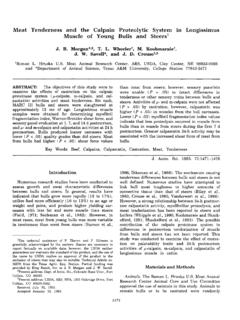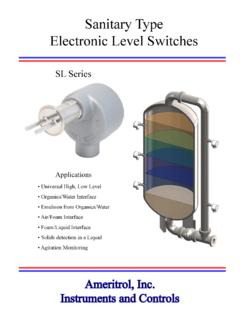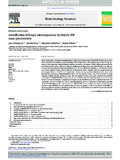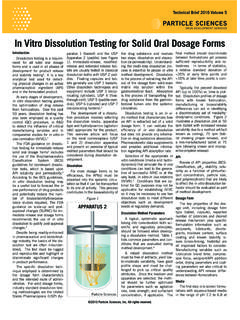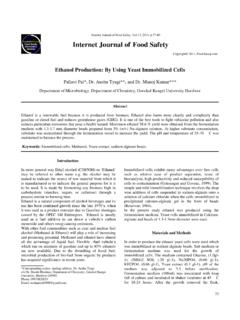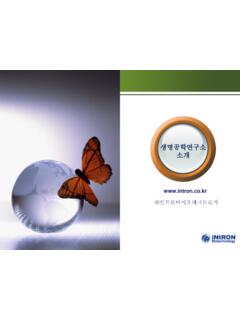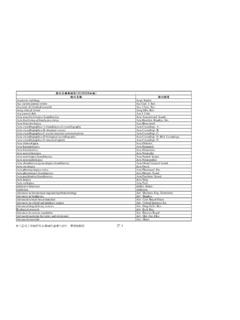Transcription of Effect of Calpastatin on Degradation of Myofibrillar ...
1 Effect of Calpastatin on Degradation of Myofibrillar Proteinsby -Calpain Under Postmortem Conditions1,2 Geert H. Geesink and Mohammad Koohmaraie3 Roman L. Hruska Meat Animal Research Center, ARS, usda , Clay Center, NE 68933-0166 ABSTRACT:To improve our understanding of theregulation of -calpain activity in situ during postmor-tem storage of muscle, the Effect of different calpastatinlevels on proteolysis of myofibrillar proteins by -cal-pain in a system closely mimicking postmortem condi-tions was studied. Increasing the amount of calpastatinin the incubations limited both the rate and extent ofproteolysis of myofibrillar proteins and autolysis of -calpain.
2 Excess Calpastatin ( , a -calpain:calpastatinratio of 1:4) did not inhibit proteolysis completely. West-Key Words: -Calpain, Calpastatin , Proteolysis, Tenderness 1999 American Society of Animal Science. All rights Anim. Sci. 1999. 77:2685 2692 IntroductionThe calcium-dependent protease -calpain has beenimplicated as a major cause of postmortem tenderiza-tion of skeletal muscle through Degradation of key myo-fibrillar and associated proteins (for review see Koohm-araie, 1996). Incubation of myofibrils with -calpainunder conditions mimicking the storage of postmortemmuscle ( , pH to and 4 C) results in degrada-tion of myofibrillar proteins similar to that observedin postmortem muscle (Koohmaraie et al.)
3 , 1986; Huff-Lonergan et al., 1996). Calpastatin , the specific inhibi-tor of the calpains, was, however, not incorporated intothese incubations. The activity ratio of -calpain:cal-pastatin is approximately 1:4, 1 , and 1 in beef,1 Mention of a trade name, proprietary product or specific equip-ment is necessary to report factually on the available data; however,the usda neither guarantees nor warrants the standard of the prod-uct, and the use of the name by the usda implies no approval ofthe product to the exclusion of others that may also be authors thank S. Hauver and E. Delgado for technical assis-tance and M.
4 Bierman for secretarial assistance. Anti-titin (clone9D10) was developed by M. L. Greaser and obtained from the Develop-mental Studies Hybridoma Bank maintained by the Univ. of Iowa,Dept. of Biol. Sci., Iowa City, IA 52242, under contract NO1-HD-7-3263 from the whom correspondence should be addressed: Box 166(phone: (402) 762-4221; fax: (402) 762-4149; E-mail: November 2, April 16, blot analysis revealed that proteolysis of myofibril-lar proteins virtually ceased after7dofincubation,despite the presence of partly autolyzed, thereforeseemingly active, -calpain.)
5 A series of incubations ofautolyzed -calpain revealed that the autolyzed formof this enzyme is unstable at an ionic strength observedin postmortem muscle. The possible significance ofthese results in terms of the regulation of -calpainactivity in postmortem muscle is , and pork longissimus, respectively (Ouali andTalmant, 1990; Koohmaraie et al., 1991b). Thus, thequestion arises of how -calpain can be active in post-mortem muscle when muscle contains an excess of cal-pastatin (Boehm et al., 1998). To the best of our knowl-edge, no studies have been performed in which all ele-ments that may influence -calpain activity inpostmortem muscle ( , pH, ionic strength, refrigera-tion temperatures, Calpastatin , and storage for up to14 d postmortem)
6 Have been studied information would further our understanding ofthe involvement of -calpain and Calpastatin in post-mortem proteolysis and postmortem , the objective of this study was to examinethe Effect of postmortem conditions on -calpain andmyofibrillar proteins in a system that closely mimicspostmortem and MethodsPurification of -Calpain -Calpain was purified from bovine sternomandibu-laris (1 kg) according to methods described by Edmundset al. (1991) with minor modifications. Briefly, musclewas trimmed of visible fat and connective tissue within1 h postmortem and homogenized in three volumes ofextraction buffer (100 mMTris/HCl, pH , 10 mMEDTA.)
7 05% [vol/vol] 2-mercaptoethanol [MCE], 100mg/L ovomucoid, 2 mMphenylmethylsulfonyl fluoride[PMSF], and 6 mg/L leupeptin). After centrifugation,GEESINK AND KOOHMARAIE2686the supernatant was salted out between 0 and 45%ammonium sulfate saturation, and, after dialysis, -calpain was purified using successive chromatographyover DEAE-Sephacel (Pharmacia LKB Biotechnology,Piscataway, NJ), Phenyl-Sepharose (Pharmacia LKBB iotechnology), Butyl-Sepharose (Pharmacia LKB Bio-technology), Mono Q (Pharmacia LKB Biotechnology),and Sephacryl S-300 (Pharmacia LKB Biotechnology).
8 -Calpain ( units/mL, 46 units/mg) was stored at4 C in elution buffer (40 mMTris/HCl, pH , .5 mMEDTA, and 1 mMNaN3). Calpain activity was deter-mined as described by Koohmaraie (1990).Purification of CalpastatinCalpastatin was purified from bovine sternomandi-bularis (.5 kg) as described by Geesink et al. (1998).Briefly, muscle was extracted as described for purifica-tion of -calpain, and 15% (wt/vol) trichloroacetic acid(TCA) was added to the extract. After centrifugation,the pellet was suspended in .1 MTris base, and the pHwas adjusted to with 1 MNaOH. This suspensionwas dialyzed against three changes ofTEMA(20 mMTris/HCl, pH , 1 mMEDTA.)
9 1% MCE, and 1 mMNaN3). The suspension was clarified by centrifuging at30,000 gmax. The supernatant was heated in a micro-wave oven to 85 C, kept in a waterbath at 90 C for10 min, and cooled on ice. Precipitated material waspelleted by centrifuging at 30,000 gmax. Calpastatinwas purified from the supernatant by successive chro-matography over Affigel blue (Bio-Rad Laboratories,Hercules, CA), Mono Q (Pharmacia LKB Biotechnol-ogy), and Sephacryl S-300 (Pharmacia LKB Biotechnol-ogy). Calpastatin ( units/mL, 906 units/mg) wasstored at 4 C in elution buffer.
10 Calpastatin activitywas determined as described by Koohmaraie (1990).Myofibril IsolationMyofibrils were prepared from bovine sternomandi-bularis within 1 h postmortem according to the proce-dures of Goll et al. (1974). Myofibrils were stored in50% glycerol, 100 mMNaCl, and 1 mMNaN3at 30 were washed three times in a mixed saltsolution (MSS:12 mMNaCl, mMMgSO4 7H2O, 70mMKH2PO4, mMNaOH, mMKOH, mMH2SO4, 132 mMlactic acid, 100 mMTris, and 1 MTriswas added to pH , 4 C) formulated on the basis ofthe postrigor sternomandibularis muscle compositionas described by Winger and Pope (1980 81).









